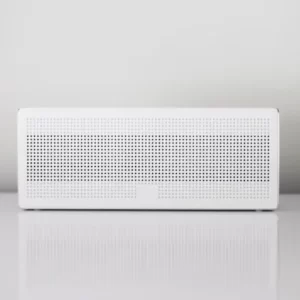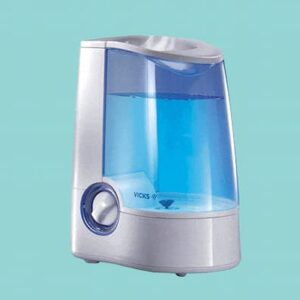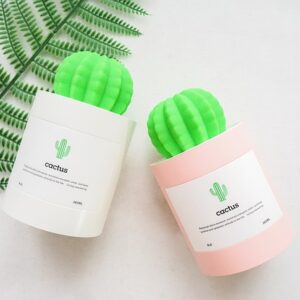When the air is too dry, humidifiers add moisture to it. The dryness of winter air is typically combated by people using humidifiers during this season.
When the air is too humid, a dehumidifier removes moisture from the atmosphere. In the spring and summer, dehumidifiers are used.
Controlling seasonal allergies and getting rid of the sticky, musty sensation a humid home can give off are the two main reasons people use dehumidifiers.
Please continue reading as I will present you with more specific information.
Table of Contents
What Does Each Do?
In order to increase the humidity of an indoor space, humidifiers essentially add moisture to the air. Here is a description of the various types of humidifiers available for purchase, as well as how they operate.
Humidifiers
Humidifiers come in two main categories: cool-mist humidifiers and warm-mist humidifiers, also sometimes called steam vaporizers.
Both of them effectively increase the air’s moisture content. Aside from your personal preference, there isn’t necessarily a benefit to one over the other.
That said, how they create moisture might make a difference in your choice between the two.
Here is how some popular cool-mist humidifier types operate:
- Impeller: Water is stirred up into tiny droplets that exit the humidifier through an opening and enter your air by way of a diaphragm, a plate made of ceramic or metal that vibrates at extremely high speeds.
- Ultrasonic: High-speed spinning of a disc submerged in water produces tiny water droplets in the form of steam that are released from the humidifier into the air.
- Evaporators: An object that moistens the air, like a belt or filter, is passed through by cool air being blown by a fan.
Briefly put, cool-mist humidifiers break down water into minute particles, which then vaporize and enter your air. They can also assist in cooling your air because the water starts out cold and never warms up.
An overview of how most steam vaporizers operate is provided below:
- A plug into an electrical outlet serves as the humidifier’s power source.
- A container of water is heated to the point of boiling by the electricity’s energy.
- Boiling water creates steam, which is cooled before it leaves the humidifier through a tube or opening so that you can breathe it in.
For those who have allergies or asthma, steam vaporizers can also be used with inhalants or essential oils.
Dehumidifiers
What humidifiers do, dehumidifiers do the opposite. These gadgets remove moisture from the air and aid in maintaining dry indoor air. A typical dehumidifier can lower the relative humidity (RH) of your indoor air to a more comfortable 30 to 50%.
This is how a typical dehumidifier operates:
- The dehumidifier uses a fan to draw warm air into metal coils, which are then cooled by a refrigerant that employs chemicals to lower the coils’ temperature.
- In essence, warm air “shrines.”” from science class? Do you recall thermal expansion? The air condenses into tiny water droplets as it contracts, and hot objects are larger than cold ones.
- Water vapor condenses from the warm air and is collected in a tank outside the dehumidifier.
- Through a tube driven by a fan, the cooler air that has had its moisture removed is blown back into your indoor environment.
Types
Types Of Dehumidifiers
An eco-friendly air dehumidifier designed for dehumidifying small to medium-sized spaces
- Mechanical/Refrigerative: This type of dehumidifier, which is the most popular, operates by drawing moist air over a cooling coil with the help of a small fan. A collecting space is where condensation drips after collecting on the coil. When the air temperature is above 65 degrees Fahrenheit (roughly 19 degrees Celsius) and the relative humidity is greater than 45%, these dehumidifiers perform at their best.
- Absorption/Dessicant: Dessicants are substances that readily take in moisture from the atmosphere. In this kind of dehumidifier, the dessicant is rotated through the space, typically on a belt, with one end of the system heated to draw the moisture out of the material. In locations with high relative humidity and low temperatures, these dehumidifiers perform well. This kind can significantly lower humidity levels, which makes them useful for industrial processes.
- Electronic: In order to create a cool surface where condensation can draw water vapor from the air, this kind of dehumidifier uses a Peltier heat pump. This kind has a low efficiency rating even though it is quiet (as it has no moving parts). For compact (under 300 cubic feet) spaces and small appliances, the electronic type is best.
- Ionic membrane: Water molecules, whether they are gases or liquids, can be taken out of the environment on a molecular level. Even though no water may be physically produced, specialized ionic membranes can help “pump” water molecules into (humidifying) or out of (dehumidifying) a sealed environment. Chemical engineering, fuel cells, and water filtration all use this type of dehumidifier.
- Makeshift: Stand-up and window air conditioners function similarly to mechanical/refrigerative dehumidifiers, especially if they evaporate the accumulated condensation outside the room while adding heat to it.
Types Of Humidifiers
- Warm Mist Humidifiers
- Steam humidifer: This popular type just boils the water, emitting steam into the space. The water may also contain aromatic or antibacterial compounds, as well as substances like medical inhalants.
- Cool Mist Humidifiers
- Evaporative/wick humidifier: This kind uses a wick, which is typically a fabric, to draw water out of a storage container. The water is then evaporated by a fan passing over the wick’s surface area. If the water is cold, it can also help to quickly lower the outside temperature, acting as a kind of portable air conditioner.
- Impeller humidifier: Large area misters of this kind are the most prevalent; they use a rotating disc to spray water onto a diffuser to produce a fine, foggy mist. The water is broken up into tiny droplets and sprayed into the air by the diffusing component.
- humidifier with ultrasound: These humidifiers use a solid or membrane-based diaphragm that vibrates at ultrasonic frequencies to disperse water into minute droplets. The mist is then released as a fog by a fan. This kind of humidifier is essentially silent because the ultrasonic vibrations are beyond the range of human hearing.
Benefits Of Each
If your air is too dry, humidifiers can help by introducing moisture. Your susceptibility to airway infections and other problems, such as:
- sore throat
- nosebleeds
- bronchitis
- sinus inflammation (sinusitis)
- cold
- influenza
Which Humidifier Should You Therefore Use?
Humidifiers that produce cool mist are safer because they don’t use hot water, which can burn you if it spills. They are safer to use around children as a result.
But if the humidifier isn’t regularly or adequately cleaned, cool mist can also spread airborne bacteria or viral material. The water in steam vaporizers is heated to kill any bacteria or other pathogens before steam is released.
A cool-mist humidifier is probably best if you have kids or pets. If hot water from steam vaporizers leaks, it could cause a burn.
How About Dehumidifiers Now?
The air is helped to dry out by dehumidifiers. If your home has recently experienced a leak or flooding, you may find this to be especially helpful.
Your home may become overly humid, which can encourage the growth of dust mites and mold, which can exacerbate asthma symptoms and cause allergic reactions. Airway constriction can result from nerve reactions in hot, humid air.
Dehumidifiers can be beneficial in the following situations:
- you have chronic or seasonal allergies
- you’ve just moved somewhere new where your allergy symptoms are worse
- your home smells wet or there are excessively moist areas of your home
- your home leaks after rain
- you see water vapor in your air at home or notice that the air feels heavy and wet
- you’re allergic to dust mites
- you have too many pests like spiders or silverfish
- your clothes take a long time to dry when you line-dry them
- you find yourself coughing or having runny noses frequently
Maintenance
Dehumidifiers and humidifiers need routine maintenance.
Maintain A Humidifier
- Water only for humidifiers should be distilled or demineralized. As a result, the growth of bacteria, mold, and debris in their reservoirs, tanks, and filters is reduced.
- Maintain the water tank and filter regularly. Water should not be kept in a tank or reservoir for longer than a day as this could encourage the growth of bacteria or mold.
- To prevent harmful chemicals from leaking, thoroughly rinse the water tank or reservoir after cleaning it.
- Maintain a dry environment close to the humidifier to reduce the chance of bacterial or mold growth there and to help identify potential leaks.
Maintain A Dehumidifier
- Regularly clean the water tank (bucket or reservoir) and coil. Allowing water to sit in the tank for more than a day can cause mold or bacteria to grow.
- Check the coil for accumulation of frost during cold weather. The dehumidifier’s effectiveness is decreased by frost.

Why Does Humidity Have An Effect On Health?
Both systems aid in the reduction of conditions like asthma, allergies, and chest congestion. Dehumidifiers, for instance, can be used to treat asthma that is brought on by humid air. Or using a humidifier will assist in breaking up sinus congestion or blocked nasal passages brought on by a cold.
How Does Humidity Affect Your Home?
The type of system you require for your home can also be determined by how it feels. A humidifier is necessary if you frequently have chapped lips, dry skin, and itchy eyes. You need a dehumidifier if the walls or ceilings have damp stains on them or if the rooms feel stuffy.
Wooden beams, plaster, and leather furniture can develop cracks as a result of dry air. A humidifier would be useful here.
Mold can develop on your home’s walls and ceilings as a result of excessive moisture. Injurious health consequences could result from this. This is avoided with a dehumidifier.
How Is Indoor Humidity Affected By The Weather?
As a result of the summer’s increased humidity, homes can become stuffy and uncomfortable. The wintertime air is chilly and dry. Heaters make the situation worse by drying out the house by removing the majority of the moisture.
Additionally, humidity can affect pest control. Moisture attracts termites, carpenter ants, and wood-boring insects.
Drier air necessitates more frequent watering for indoor plants if you have any. However, these plants are more likely to contract a disease when the air is humid.
Although portable humidifiers and dehumidifiers are effective, they are difficult to maintain, so you might need to distribute several of them throughout your house. Burkholder’s HVAC offers an alternative solution, whole-home humidifiers, and dehumidifiers. These appliances are installed as a part of the heating and cooling system in your house. Based on the temperatures inside and outside, the device automatically regulates and modifies the humidity level in your home. Your home’s humidity level will always be known thanks to automatic control, giving you the assurance that it is being properly maintained.
What Justifies Maintaining Indoor Humidity?
Extremely high levels of humidity in your home can put you and your family through a great deal of discomfort. If your home’s humidity is off, even if you take all the necessary steps to maintain the ideal room temperature, it might still not feel comfortable. Both high and low humidity levels can result in dehydration because they interfere with your body’s natural cooling process, i.e., sweating.
In addition, inadequate humidity levels are linked to a number of health-related problems. Bad humidity can even damage the appearance of your home if it was built with a lot of wood.
Which Is Better: A Dehumidifier Or A Humidifier?
Between 30% and 50% is the range for ideal indoor humidity. You should first assess the humidity levels in your home before making a humidifier or dehumidifier purchase. For a precise picture, track those levels for at least a week. You ought to purchase a humidifier if the numbers are close to or below 30. You should purchase a dehumidifier if the figures reach 50 or higher. The humidity levels typically rise in the summer and fall in the winter. Consequently, the weather has a significant impact on the choice.
It is preferable to pair your humidifier or dehumidifier with a smart device so you can use your phone to control it and it will keep the right humidity levels in your home automatically. As long as they include an IR-based remote control, smart controllers like the Cielo Breez can be used with both.
Conditions They Help
Here are a few common respiratory conditions that a humidifier or a dehumidifier can help you with:
- Asthma: By moistening the dry air, a humidifier can reduce the risk of infections and the drying out of your airways. A dehumidifier can lessen excessive moisture, improve breathing conditions, and prevent airborne pollutants from hanging around in the atmosphere.
- Allergies: Humidifiers can help you breathe easier by reducing sinus inflammation and adding moisture to dry, allergen-filled air. They can even assist with sinus issues that aren’t allergies. Dehumidifiers can aid in drying out overly moist environments where allergens like mold and dust mites can flourish.
- Bronchitis: A humidifier can help reduce symptoms and occurrences of bronchitisTrusted Source. A dehumidifier can also reduce mold and bacteriaTrusted Source that may trigger bronchitis.
- Cold: Coughing and wheezing are two cold symptoms that a humidifier can help with.
For babies and young children, especially if they have allergies or asthma, humidifiers and dehumidifiers can also help maintain your indoor air at a comfortable relative humidity (RH) level. Controlled humidity makes breathing a little easier for everyone.
Can An Air Conditioner Replace A Dehumidifier/humidifier?
The main purposes of an air conditioner are to supply cool air into the space and exhaust hot air. The opposite is also possible with a reversible heat pump, i.e., it provides both heating or cooling. An air conditioner can slightly lower indoor humidity while removing the hot air. But compared to a dehumidifier, its capacity to reduce humidity is much lower. To learn more about air conditioner vs., read our blog. dehumidifier.
An air conditioner cannot humidify the air because it is cooling the air by taking moisture out of it.
However, it is best to use a smart AC controller along with your air conditioner if you don’t want to spend money on a humidifier or a dehumidifier.
What About Air Purifiers?
Air purifiers simply pull air from your indoor space, filter out particles and other air pollutants from that air, and then recirculate the clean air into the space.
The majority of air purifiers don’t have a humidifying or dehumidifying system.
By removing moisture from the air as it passes through the filters, air purifiers can occasionally help lower humidity. However, they don’t work as well as dehumidifiers in this regard, and too much moisture can eventually harm filters.
Nevertheless, because they can eliminate airborne pollutants that can precipitate respiratory symptoms, air purifiers are useful tools for the treatment of allergies and asthma.
Some air purifiers can also eliminate fine particles from the air, which are typically referred to as PM2.5 because they are smaller than 2.5 micrometers.
PM2.5 is small enough to pass from the air sacs in your lungs, called bronchioles, into your bloodstream and cause heart, lung, and brain conditionsTrusted Source.
An air purifier can be beneficial for a number of ailments, such as:
- allergies
- asthma
- lung and respiratory conditions
- cardiovascular conditions
Which Should I Get?
Most homes have a humidity level of between 30% and 50%. A dehumidifier is required if the relative humidity in your home is higher than 50%. A humidifier is required, though, if the relative humidity is less than 30%.
Pick up a hygrometer at a home improvement store for less than $20 to find out how humid your home is.
Conclusion
The ideal humidity range for homes is typically between 30% and 50%. Get a dehumidifier if the humidity level in your house is higher than 50%. A humidifier would be preferable if the humidity was under 30%.
Use a hygrometer to determine the humidity level in your house.
In general, many places experience significantly higher humidity levels during the summer months than they do during the winter months. So, whether to purchase a humidifier or a dehumidifier depends on the weather as well.
These devices can all be connected to smartphones thanks to technological advancements. The right humidity levels will be maintained and your unit will be easier to control.
As long as these two appliances have an IR-based remote control, smart controllers will function flawlessly with them.
We appreciate you reading.





